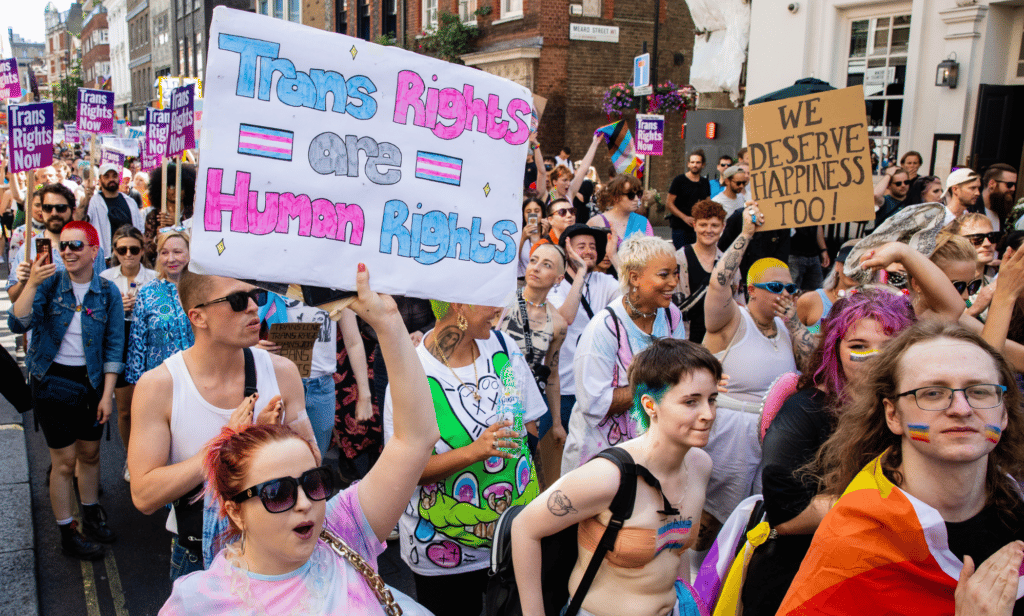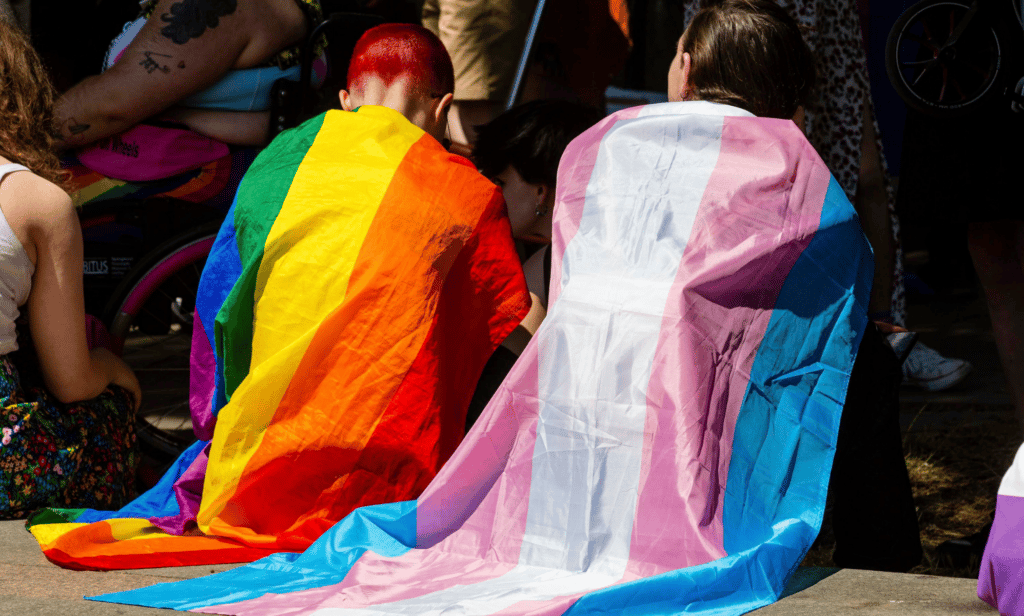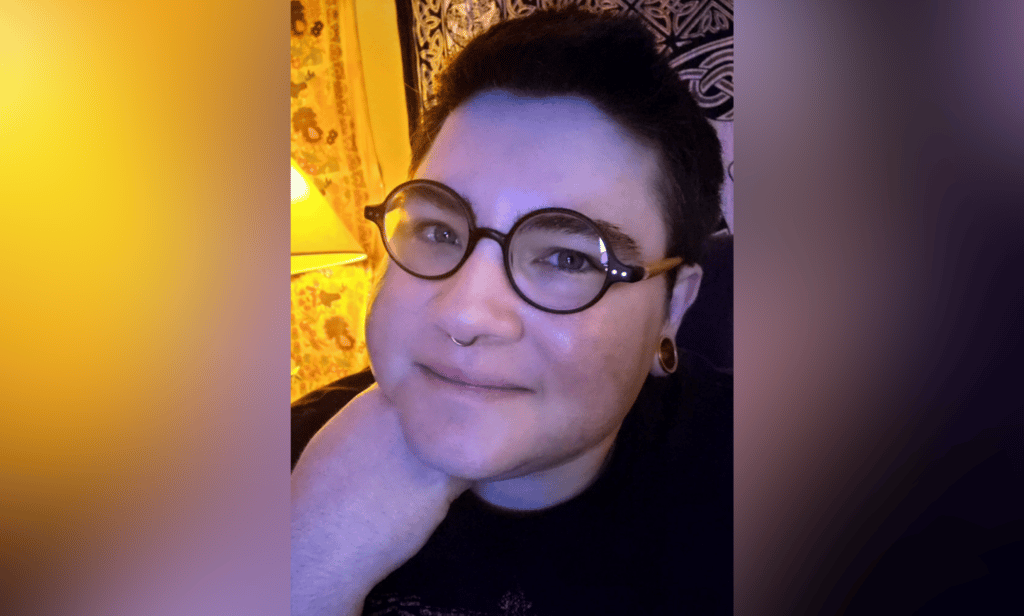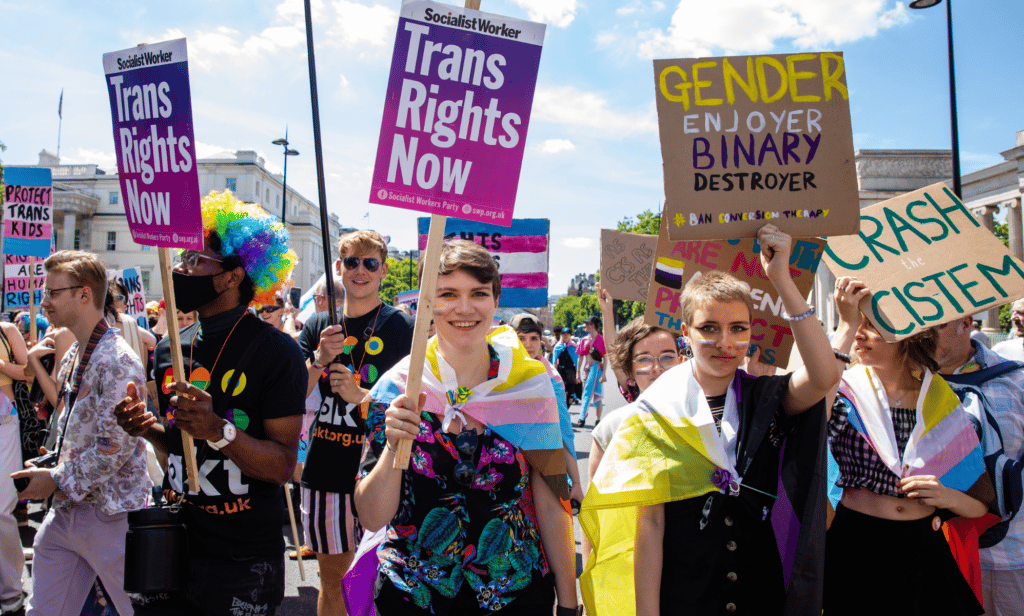What is chest binding and how does it help LGBTQ+ people feel trans joy?

LGBTQ+ people open up about feeling “something resembling peace” when they affirming their identity by wearing a chest binder. (Getty)
Chest binding and the use of binders has come under media scrutiny in recent days after The Telegraph newspaper ran a story claiming trans youth charity Mermaids is giving chest binders to “children behind parents’ backs”.
The piece largely relied on an unidentified adult posing as a trans teen to access Mermaids’ vital services and it was reported charity staff agreed to send them a free chest binder.
Binders, and the act of binding, has horrified the right-wing press, but for trans people who’ve used a chest binder, it can be a vital step in their journey and affirmation of who they are.
Binding is a practice of using a garment or cloth to compress or minimise chest tissue to achieve a flatter or more traditionally masculine chest appearance. Each person’s journey and decision on how to affirm their identity is as unique as the individual themselves. Some people choosing to bind daily, others don’t do it at all.
Mermaids responded to the media criticism with a statement saying it takes a “harm reduction” stance with the understanding that providing trans youth with chest binders and comprehensive safety guidelines from knowledgeable staff is preferable to “likely alternative of unsafe practices” or continued dysphoria.
There are some potential risks when using a binder, but charities such as Mermaids are also able to give advice on safe use and best practice.

What is chest binding?
Some transmasculine, non-binary, genderqueer or gender non-conforming people may choose to practice various ways to reduce gender dysphoria or present in a way that’s more in-line with their gender identity.
There are several methods people use to decrease the appearance of chest tissue including use of commercial binders, sports bras, high compression garments or layering clothing.
Chest binding can enable many people to express themselves more authentically. It can help support self-esteem, mental health and identity affirmation while also helping to manage dysphoria.
People need to be aware of the associated health risks of compressing chest tissue and improper binding practices as it can negatively impact an individual’s physical health. There are many resources – including from Mermaids – regarding best practices for binding.
The Crown star Emma Corrin – like Byron, Michael and Ryleigh – has also worn a binder as they grew into their gender identity, and spoke about the experience in a powerful Instagram post in 2021.
Corrin, who played Princess Diana in the Netflix series, described it as a “journey” with “lots of twists and turns and change”.
Despite conservative media outlets continuing to rage against binders, the garment holds a special place in many trans masculine, non-binary and gender non-conforming peoples’ hearts, and in some cases has become emblematic of their journey to their authentic selves.
That’s the case for Byron, a 27-year-old public relations specialist from Oregon, who tells PinkNews he started using a binder during what he felt was a “long and drawn-out transition” when he was in his teens.
‘Having a flat chest was incredible beyond belief’
“Eighteen was when I pieced together why I wanted – no needed – to transition,” Byron says.
“I would have moments where I would actually be shocked to feel curves on my chest or be unable to really recognise what I looked like in a mirror even though I saw myself in it every day.”
Byron received his very first binder from an LGBTQ+ non-profit organisation and says wearing it was a “revelation”. Wearing his first binder wasn’t comfortable, but he finally “felt something resembling peace”.
“As much as having a visible chest/breasts was discomforting, the relief of having a flat chest was incredible beyond belief,” he says.
“When I looked in a mirror and put on a t-shirt, that was one of the first times in literal years that I remember really recognising the person I saw in the mirror.”

Wearing a binder helped him feel a “bit more at ease just living in the world at large” but it was “always a low moment” to take it off at the end of the day.
He had top surgery later, and says it was “even more of a relief”, and remembers waking up to a “free chest”.
‘I’m meeting myself. I want you to meet me too’
Michael C, from Texas, “came very late to an understanding” of themself, so it wasn’t until December 2021, at 37-years-old, when they got their first binder.
They describe feeling a “release” from dysphoria – a word he says he wouldn’t fully comprehend until January of the next year when their “egg fully cracked” – when they started wearing the binder.
“That singular act of love toward myself with regard to something I was either actively ignoring or spent in curling discomfort from, changed everything,” Michael tells PinkNews.
“For the first time in memory, I could actually see something of myself in the mirror.”
“I didn’t pick, scratch, grumble or shift against the grain of my appearance. I just laughed and fluttered around my bathroom, my cheeks rosé pink and face tingling from smiling.”
They were so euphoric, they sent “champagne bubble selfies” to their friend.
“I couldn’t contain it! Look! Look! I’m meeting myself and I love it and I want you to meet me too!”

Michael says, since that “mustard seed act”, they have been able to grow further in their identity and wearing a binder allowed them “space to be”.
‘Chest binding let me be me, even a little bit’
Today, Ryleigh, who’s in their early 20s and lives in South Yorkshire, isn’t binding as often as they used to – they’ve found other ways to feel comfortable in their skin as an adult. But Ryleigh says binding was a “lifeline” for them, especially in their early teenage years.
“I was deeply uncomfortable with my chest before I realised what being transgender was, and it wasn’t a problem that would go away; as far as pre-teen me knew, I was stuck with them for life, and I hated it so badly,” they tell PinkNews.
They read blog posts, scoured forums and watched videos of trans YouTuber Alex Bertie discussing safe chest binding practices before purchasing their own binder.
“I remember putting it on for the first time in the bathroom – I didn’t keep mirrors in my bedroom – and seeing myself.
“Someone like me will never be flat in a binder; it’s not possible. but it was as close as I was ever going to get. When I put on a loose shirt, you couldn’t tell.”

Ryleigh still has all of their old binders and say they don’t think they could get rid of them because they were a vital stepping-stone on their journey toward living as their authentic self.
“They were the first things I had that let me be me, even a little bit.
“I have more ways now, and with a lot of external support, I don’t need them as much but they’re so important to me.”

